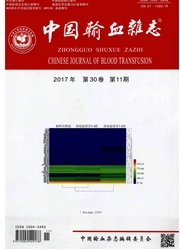

 中文摘要:
中文摘要:
目的探讨输注同种脾细胞建立小鼠输血相关的移植物抗宿主(TA-GVHD)模型及其特点。方法分离C57BL/6(H-2^d)脾细胞,分别经静脉输注给Balb/c(H-2^d)裸鼠与F1代(C57BL/6×Balb/cH-2^b/d),建立输血相关的移植物抗宿主模型。活体染料羧基荧光素乙酰乙酸(5,6-carboxynuorescein diacetate succinimidyl ester,CFSE)标记供者脾细胞,通过流式细胞仪分析供者细胞在受者体内的增殖;免疫组化分析供者脾细胞survivin的表达;检测Balb/c裸鼠体内抗供者抗体及IL-10浓度;分析皮肤、小肠、肝脏的病理变化。结果输注同种脾细胞成功建立急性TA-GVHD模型。受者脾脏及外周可以检测到标记后增殖的供者细胞。小鼠的病理改变主要出现在肝脏,浸润细胞早期表达survivin。小肠及皮肤末见明显的病理改变。TA—GVHD裸鼠第7天IL—10、抗-Balb/c显著升高。结论输注同种脾细胞可以建立TA—GVHD模型,并具有简单、快速、稳定的特性,为诊断、治疗GVHD提供了良好的模型。
 英文摘要:
英文摘要:
Objective To develop transfusion associated graft vs host disease(TA-GVHD) model by infusing allogeneic splenocytes. Methods C57BL/6 (H-2^b) splenocytes were harvested, labeled by 5,6-carboxyfluorescein diacetare succinimidyl ester (CFSE), and infused into Balb/c nude mice (H-2^d) and FI mice (C57BL/6 × Balb/c, H-2^b/d) to develope TA-GVHD model. Labeled donor splenocytes were detected by flow cytometry. Survivin expression of donor splenocytes in host liver was detected by immunohistochemistry. Anti-donor antibody and IL-10 in serum of Balb/ c nude mice were measured by complement-dependent cytotoxicity and ELISA, respectively. Results TA-GVHD could be developed by infusing allogeneic splenocytes. Donor cells were detected in the spleen and peripheral blood of recipient. Liver injury was serious but no injury in the skin and the intestine was observed. The expression of survivin in lymphocytes was detected in the liver of FI and nude mice. TA-GVHD nude mice had high concentrations of IL-10 and anti-Balb/c antibodies after splenocyte infusion. Conclusion TA-GVHD model can be established in nude Balb/ c and F1 mice by infusing allogeneic splenocytes.
 同期刊论文项目
同期刊论文项目
 同项目期刊论文
同项目期刊论文
 期刊信息
期刊信息
